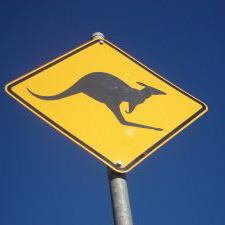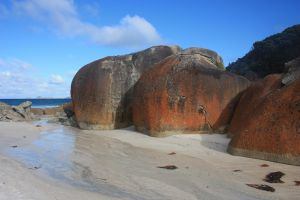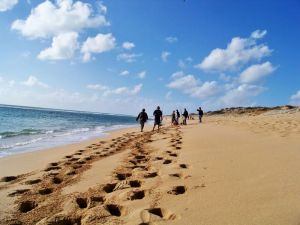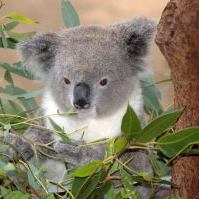Travel Tips
New Work Visa Policies Between US and Australia: Jobs for Backpackers and Budget Travelers
 Historically, when young people from other countries tried to work in the U.S., the government didn’t exactly roll out the red carpet.
Historically, when young people from other countries tried to work in the U.S., the government didn’t exactly roll out the red carpet.
In fact, Uncle Sam made getting a visa in the States so restrictive that other nations enacted this quid pro quo policy: If we can’t get a job in your country, don’t bother trying to work in ours.
This tit-for-tat ridiculousness finally came to an end on October 31, 2007 when a new visa deal, supported by former Australian Prime Minister John Howard and former President George W. Bush, was signed between both nations.
Australians ages 18 to 30 were granted permission to spend a year working in the United States, and their American counterparts were given the chance to do the same thing Down Under.
This landmark new 12-month visa wasn’t available when I backpacked through Australia from April to June 2007, but I’d heard rumors that it was in the works. I remember thinking: What an incredible opportunity for Americans to live and work in the world’s most laid-back nation—and earn two to four times the U.S minimum wage while doing it.
 When the visa became official two months later, the news was almost enough to make me turn tail and hop a flight back to Oz.
When the visa became official two months later, the news was almost enough to make me turn tail and hop a flight back to Oz.
According to Brett Claxton, chairman of the promotional organization Backpacking Queensland, Americans are only the most recent group to benefit from this reciprocal working holiday arrangement. Australia has similar deal with 21 countries worldwide, and welcomes 85,000 “working-holiday makers” a year.
Not only do these visa holders fill a large void in the number of seasonal and manual laborers willing to work in Australia (as much as 20 percent of the resident population is abroad at any given time), but travelers often end up spending their hard-earned cash on things like surf camp, live-aboard scuba trips and well, copious quantities of beverages. Employers get staffers, tourism operators get customers, travelers get bragging rights and the government gets AU $195 per person. Everybody wins.
 While Claxton wasn’t aware of any single centralized Web site for job seekers (seek.com.au and mycareer.com.au do have some listings) he explained that many backpackers simply show up and apply for work in person once they arrive. And since they’ve only got three months to hightail it Australia once their visa is approved, it makes sense to pack now and secure work later.
While Claxton wasn’t aware of any single centralized Web site for job seekers (seek.com.au and mycareer.com.au do have some listings) he explained that many backpackers simply show up and apply for work in person once they arrive. And since they’ve only got three months to hightail it Australia once their visa is approved, it makes sense to pack now and secure work later.
The upswing is, there’s no shortage of positions available for young people willing to work. The most common jobs including waiting tables, bartending, fruit picking, construction, retail sales, childcare, and cleaning services. Not challenging enough?
Those who make a case for themselves and have the skills can get into fields like into nursing, dive instruction, hotel management, or marketing. Visa holders are advised to bring several copies of their resume—and to get a cell phone soon after arrival in order for potential employers to reach them.
 What kind of job traveler takes really depends on their qualifications—and they’re hoping to get out of the trip. Social butterflies may want to snag a position slinging drinks in one of the backpacker epicenters like Cairns or Airlie Beach, while those trying to save some serious cash should seek a well-paying jackaroo (ranch hand) position far from town and retail temptation.
What kind of job traveler takes really depends on their qualifications—and they’re hoping to get out of the trip. Social butterflies may want to snag a position slinging drinks in one of the backpacker epicenters like Cairns or Airlie Beach, while those trying to save some serious cash should seek a well-paying jackaroo (ranch hand) position far from town and retail temptation.
Young people who know their way around a boat—whether that’s the rigging up top or the galley kitchen down below—can earn their place on one of the crews that sail yachts around the 74 pristine island at the base of the Great Barrier Reef. In fact, according to Keith Roberts, co-owner of the sailing company Islandive (www.islandive.com), if you can play the guitar, entertain a large group of people, or take a killer photograph, you may well be qualified to work on one of his boats.
Those who are a short in the marine skills department, or just prefer to stay on dry land, might consider taking a position working at one of the thousands of cattle stations or farms dotted throughout Australia. The work can be pretty sweaty, but as I discovered during my overnight stay at Springbrook Farm, located four hours outside of Brisbane, inordinately fun. During our single-day training course, my group and I learned how to tear through the countryside on motorbikes (used to herd sheep), muster runaway cattle on horseback (just like City Slickers!) and drive a tractor.
 We missed our chance to learn to saw logs with chainsaws and mend barbed-wire fences, but travelers who complete the week-long program with Visitoz (www.visitoz.org) get to engage in all of the farm’s testosterone-driven activities—and are placed in jobs at the conclusion of the program.
We missed our chance to learn to saw logs with chainsaws and mend barbed-wire fences, but travelers who complete the week-long program with Visitoz (www.visitoz.org) get to engage in all of the farm’s testosterone-driven activities—and are placed in jobs at the conclusion of the program.
Visitoz owner Dan Burnet shared that even the most inexperienced farm hands can pocket about AU $500 per week, while those who can handle specialized tasks (such as driving enormous tractors and training polo ponies) may take home as much as AU $1,500 per week.
Travelers who won’t be content with anything less than the “Best Job in the World” (a position recently scored by British charity worker Ben Southall) may want to apply to become a “Van-Tastic Adventurer” for travel-insurance provider World Nomads (www.worldnomads.com).
The company wants to hire seven pairs of drivers to take a karmic campervan named Geoff across Australia’s seven states. The winning applicants will be flown from anywhere in the world to get started, given the keys to the van, a digital video camera, a laptop, and $1,000 worth of gas. All they have to do is share their adventures online via short videos, blogs, photos, and podcasts.
Sound like the perfect vacation, um … job? Go here to apply: https://vantastic.worldnomads.com
For more info on the Work and Holiday Visa for Americans (subclass 462), visit www.immi.gov.au
By Amanda Pressner for PeterGreenberg.com. Visit Amanda and the other “Lost Girls” on the Web at www.lostgirlsworld.blogspot.com. Their debut book, The Lost Girls, will be out from HarperCollins in 2010.
Amanda Pressner recently reported from Australia for a Destination: Sydney series. Check out her reports:
Learn how you can get to Australia for less in Budget Travelers Rejoice: Competition Makes Australian Airfares Cheaper Than Ever.
Learn more about traveling to Australia & New Zealand, with one of our newest destination-specific sections of PeterGreenberg.com. For example, you’ll find our Off the Brochure Guide to Australia.
If you’re spending some time in Sydney, find out if the SydneyPass tourist discount card is a good deal.












